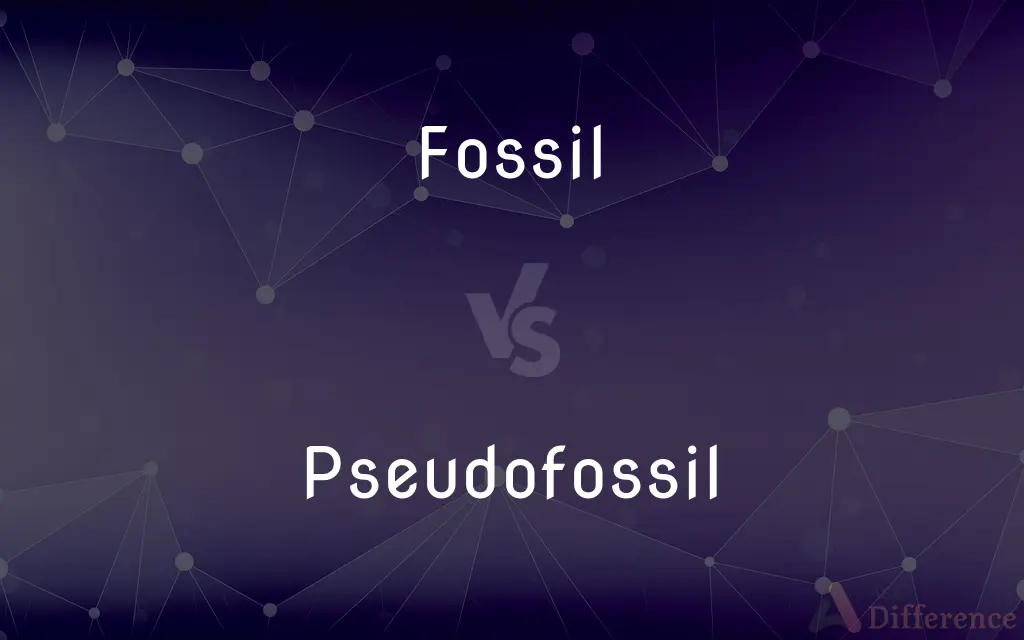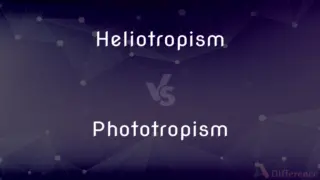Fossil vs. Pseudofossil — What's the Difference?
Edited by Tayyaba Rehman — By Maham Liaqat — Updated on April 18, 2024
Fossils are the preserved remains of ancient life forms, showcasing real biological parts, while pseudofossils are inorganic patterns that mimic biological structures but have no organic origin.

Difference Between Fossil and Pseudofossil
Table of Contents
ADVERTISEMENT
Key Differences
Fossils are the actual remains or impressions of ancient organisms preserved in rock, often showcasing detailed biological structures. On the other hand, pseudofossils appear similar but are formed through geological processes like mineral deposits, without involving any living organisms.
Fossils often provide valuable information about the morphology, behavior, and evolution of life forms. Whereas pseudofossils, though lacking in biological content, can still inform geologists about the environmental conditions and mineral compositions of the past.
Fossils can be dated to provide precise information about the age of the geological layers in which they are found. Pseudofossils, however, do not provide direct information on chronology since they are not derived from living entities.
The study of fossils is crucial in fields like paleontology and archaeology as it directly relates to biological entities. Conversely, the study of pseudofossils falls under the domain of geology and mineralogy, focusing more on rock formation and properties.
Fossils are categorized based on the types of organisms and the manner of preservation, such as petrified wood or amber. Pseudofossils do not have such classifications as they are not actual organisms but are often grouped by their visual similarities to biological structures.
ADVERTISEMENT
Comparison Chart
Definition
Preserved remains of organisms
Inorganic patterns resembling organisms
Origin
Biological
Geological
Scientific relevance
Paleontology, archaeology
Geology, mineralogy
Dating
Can be precisely dated
No direct dating possible
Classification
By organism and preservation
By appearance
Compare with Definitions
Fossil
A preserved specimen of an organism in amber.
The amber fossil encloses a perfectly preserved insect.
Pseudofossil
A pattern in rocks that looks like a fossil but isn't biological.
That pseudofossil resembles a leaf but is just a mineral stain.
Fossil
Any evidence of ancient life preserved in geological context.
The limestone is rich in marine fossils.
Pseudofossil
An accidental shape in stone that mimics biological structures.
The pseudofossil formed by iron oxide traces looks surprisingly like a feather.
Fossil
Remains of a prehistoric organism preserved in petrified form.
Fossilized leaves can be seen embedded in the rock.
Pseudofossil
A misleading geological feature that appears to be an ancient organism.
On closer examination, the supposed fossil was just a pseudofossil.
Fossil
A petrified piece of bone or wood.
A fossil of a tree trunk was unearthed.
Pseudofossil
Inorganic mimicry of fossilized remains in rocks.
These pseudofossils often confuse amateur collectors.
Fossil
A trace of an ancient organism in the form of an impression.
The fossil shows the impression of a dinosaur's foot.
Pseudofossil
A rock formation that imitates biological remains without containing any.
What appeared to be a fish skeleton turned out to be a series of pseudofossil cracks.
Fossil
A fossil (from Classical Latin: fossilis, literally 'obtained by digging') is any preserved remains, impression, or trace of any once-living thing from a past geological age. Examples include bones, shells, exoskeletons, stone imprints of animals or microbes, objects preserved in amber, hair, petrified wood, oil, coal, and DNA remnants.
Pseudofossil
Pseudofossils are inorganic objects, markings, or impressions that might be mistaken for fossils. Pseudofossils may be misleading, as some types of mineral deposits can mimic lifeforms by forming what appear to be highly detailed or organized structures.
Fossil
A remnant or trace of an organism of a past geologic age, such as a skeleton or leaf imprint, embedded and preserved in the earth's crust.
Pseudofossil
Any object, marking or impression that resembles a fossil but whose origin is non-biological.
Fossil
One that is outdated or antiquated
He was viewed as a fossil after decades in the same job.
Fossil
A word or morpheme that is used only in certain restricted contexts, as kempt in unkempt, but is otherwise obsolete.
Fossil
An archaic syntactic rule or pattern used only in idioms, as so be it.
Fossil
Characteristic of or having the nature of a fossil.
Fossil
Being or similar to a fossil.
Fossil
Belonging to the past; antiquated.
Fossil
The mineralized remains of an animal or plant.
Fossil
(paleontology) Any preserved evidence of ancient life, including shells, imprints, burrows, coprolites, and organically-produced chemicals.
Fossil
(linguistics) A fossil word.
Fossil
(figuratively) Anything extremely old, extinct, or outdated.
Fossil
(figuratively) An extremely old or outdated person.
Fossil
Dug out of the earth; as, fossil coal; fossil salt.
Fossil
Preserved from a previous geological age; as, fossil water from deep wells; - usually implying that the object so described has had its substance modified by long residence in the ground, but also used (as with fossil water) in cases where chemical composition is not altered.
Fossil
Like or pertaining to fossils; contained in rocks, whether petrified or not; as, fossil plants, shells.
Fossil
A substance dug from the earth.
Fossil
The remains of an animal or plant found in stratified rocks. Most fossils belong to extinct species, but many of the later ones belong to species still living.
Fossil
A person whose views and opinions are extremely antiquated; one whose sympathies are with a former time rather than with the present.
Fossil
Someone whose style is out of fashion
Fossil
The remains (or an impression) of a plant or animal that existed in a past geological age and that has been excavated from the soil
Fossil
Characteristic of a fossil
Common Curiosities
Can pseudofossils be used for dating rocks?
No, pseudofossils cannot be used for dating rocks as they do not contain organic material and thus do not provide any information on the rock's age.
What is a fossil?
A fossil is the preserved remains, impression, or trace of a once-living organism from a past geological age.
What is a pseudofossil?
A pseudofossil is a natural rock formation or mineral pattern that mimics the appearance of a fossil but is not derived from biological organisms.
What types of organisms are commonly found as fossils?
Many organisms can be found as fossils, including plants, animals, and bacteria, typically those that had hard parts such as shells, bones, or wood.
Why do pseudofossils look like real fossils?
Pseudofossils resemble fossils due to coincidental shapes and patterns in rocks that happen through geological processes, often involving the deposition and hardening of minerals.
How can one differentiate between a fossil and a pseudofossil?
Examining the structure and composition under a microscope can help differentiate, as fossils will show cellular or organic structures, whereas pseudofossils will not.
What are the most common pseudofossil formations?
Common pseudofossil formations include dendrites (tree-like mineral patterns) and concretions (hard, compact masses of mineral matter).
What is the importance of studying fossils?
Studying fossils helps scientists understand past life forms, evolutionary processes, and historical ecological conditions.
Can fossils be found in any rock type?
Fossils are mostly found in sedimentary rocks, as these rocks form from the accumulation of sediment which can bury and preserve organic remains.
How are fossils formed?
Fossils are formed through various processes such as permineralization, where minerals fill the cellular spaces of an organism, or by impressions left in mud or clay that harden over time.
What is the scientific significance of pseudofossils?
While pseudofossils do not provide biological insights, they are important for understanding geological processes and mineral distributions.
Are pseudofossils common, and where can they be found?
Pseudofossils are relatively common in geological formations and can be found worldwide, often in areas with high mineral content.
What methods are used to date fossils?
Methods like radiometric dating, relative dating, and using index fossils are commonly used to determine the age of fossils.
Are there any specific tools required to study pseudofossils?
Tools such as magnifying glasses, microscopes, and mineral testing kits can be useful in studying pseudofossils.
How does the study of fossils contribute to the field of geology?
Fossil studies contribute to geology by providing data on stratigraphy, helping to date and correlate rock layers across different geographical areas.
Share Your Discovery

Previous Comparison
Heliotropism vs. Phototropism
Next Comparison
Bowls vs. BoulesAuthor Spotlight
Written by
Maham LiaqatEdited by
Tayyaba RehmanTayyaba Rehman is a distinguished writer, currently serving as a primary contributor to askdifference.com. As a researcher in semantics and etymology, Tayyaba's passion for the complexity of languages and their distinctions has found a perfect home on the platform. Tayyaba delves into the intricacies of language, distinguishing between commonly confused words and phrases, thereby providing clarity for readers worldwide.
















































